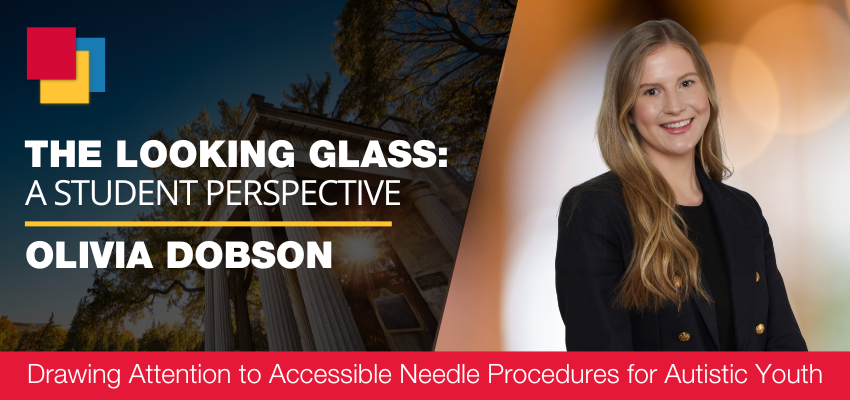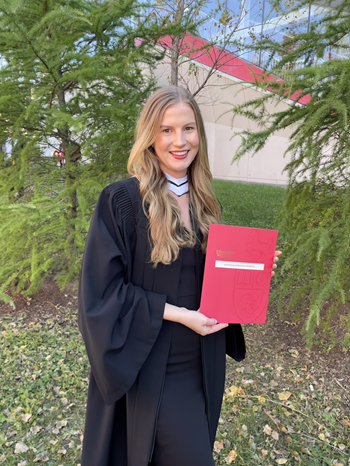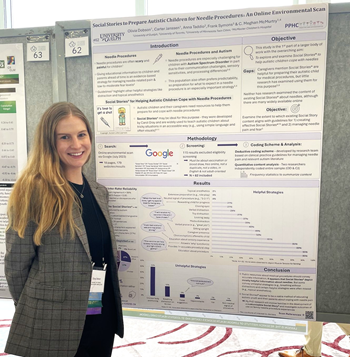The Looking Glass — Drawing Attention to Accessible Needle Procedures for Autistic Youth

Olivia Dobson is a PhD Candidate in the Department of Psychology’s Clinical Child and Adolescent Psychology (CCAP) program.
Under the supervision of Dr. Meghan McMurtry in the Pediatric Pain, Health and Communication (PPHC) Lab, Olivia’s research focuses on making needle procedure more comfortable for autistic youth and their caregivers.
The Looking Glass: Drawing Attention to Accessible Needle Procedures for Autistic Youth
My passion for working with children with neurodevelopmental differences and their families led me to pursue clinical child psychology at the University of Guelph. Before graduate school, I was disheartened by how inaccessible many services and programs were for autistic youth, including dance programs, which led me to create the first accessible dance program in a rural area of Nova Scotia in 2018.

Autism Acceptance Day on April 2nd offers an opportunity to draw attention to and better understand the accessibility challenges that autistic youth and their families face. Relevant to the work that we do in our PPHC lab, there are many ways that medical procedures and environments are often inaccessible for autistic children.
Some of our work in the PPHC Lab focuses on helping families cope with needle procedures. Needle procedures like vaccinations and blood draws are an essential part of healthcare but are often associated with pain and fear for children.
Autistic children are especially at risk for having difficulty with needles. For example, there are high rates of needle fear amongst autistic children, and procedural environments can be distressing for individuals with sensory sensitivities (e.g., bright lights, unfamiliar people).
My supervisor, Dr. McMurtry, and I noticed a gap in the research—there are few studies on resources to help autistic children, and their caregivers, cope with needle procedures like vaccination. With Flu season well on its way in Canada and springtime school-based vaccinations underway, it is as important as ever to find ways to make vaccinations a more accessible experience for autistic children.

In my master's research, we asked caregivers of autistic youth what they need to make needle procedures more comfortable. One key insight they shared was the value of Social StoriesTM.
Developed and trademarked by Carol Gray, Social Stories are a social learning tool designed to help autistic children navigate unfamiliar or challenging situations. Caregivers highlighted that Social Stories could be a useful and accessible way to prepare autistic youth for needle procedures.
Next, we looked at the Social Stories online to see how consistent they were with best practices and identified areas for improvement. Now, I’m developing a Social Story resource to help autistic youth and their families cope with the vaccination experience. Titled “What Happens When I get my Vaccine?”, our Social Story guides readers through the procedure step by step while incorporating science-backed coping strategies.
We Need Your Help!
We are currently looking for feedback on our Social Story resource and would love to hear from you if you are one of the following:
- An autistic youth (7-18 years old) or a caregiver of an autistic youth
- A professional who works with autistic youth (e.g., psychologist, occupational therapist)
- A professional who gives vaccinations (e.g., nurse, physician).
The flyers for our different interest groups are linked above. Feel free to explore them to learn more about our study. If you're interested or have any questions, please don't hesitate to contact me directly at odobson@uoguelph.ca.
In June of 2025, Dr. McMurtry and I are looking forward to presenting at the International Symposium on Pediatric Pain (ISPP)! As part of my presentation, I will be discussing accessible educational resources, including our work on Social Stories for coping with needle procedures.
Overall, our work thinks outside of the box to find ways to meet the unique needs of autistic youth. Ultimately, I hope that our research continues to increase awareness about the ways we can make needle procedures more comfortable for autistic children.